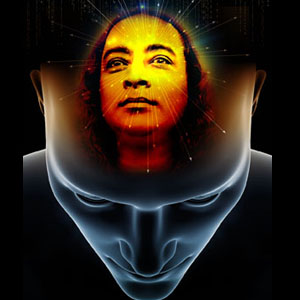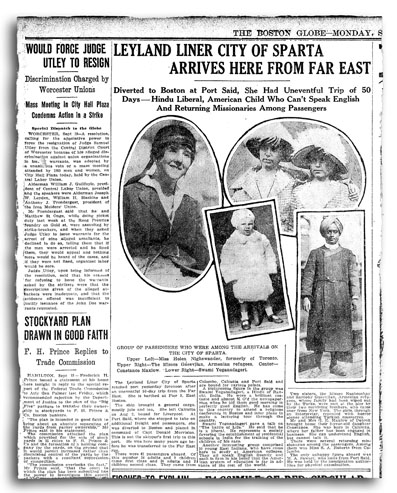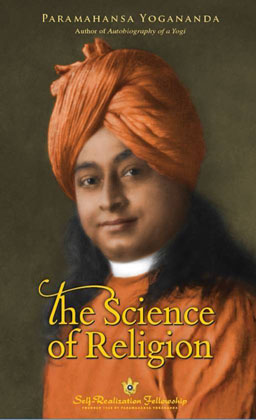Icons: The Messiah of Self-Realization

Swami Vivekananada laid the groundwork for American interest in Eastern spirituality. Then a generation later, PARAMAHANSA YOGANANDA spread that interest far and wide. Here’s a look at his legacy on the occasion of the centennial of his arrival in America.
On September 19, 1920, a ship called City of Sparta docked in Boston Harbor. The first passenger ship to sail from India to America since the outbreak of World War I, it had left Calcutta on August 2 with a cargo of merchandise and 61 passengers. A few were photographed for the Boston Globe, including a man in a turban and a full-length tunic, both no doubt orange, identified as “a Hindu of Ranchi, India,” who shocked reporters when he “bid them good morning in perfectly good English.” His name was Swami Yogananda.
Adept at adaptation
Only 27 at the time, Yogananda appears stately and dignified in the black-and-white photo. If anyone back in Calcutta had seen the picture, they would have been surprised to see that he was clean-shaven. He had shaved during the voyage because fellow passengers said a beard would attract unpleasant reactions from Americans. So would his long hair, he was told, but trimming it would have violated custom for a swami. For the rest of his life, almost all of which was spent in America, he remained beardless and long-haired, although he would often gather the hair and tuck it into the collar of his coat or under his hat when he wore Western clothing in public to avoid unwanted attention.
Such adjustments were wise for a stranger in a strange land, some of whose inhabitants were hostile to the dark-skinned and the foreign. Yogananda would continue to adapt, both in small ways—learning to use the subway, operate new gadgets, and select food in self-service cafeterias to name a few—and in important ways: by skillfully adapting the wisdom of India’s sages to reach American seekers. He learned quickly which language worked best, which needs and values to appeal to, and which means of communication to employ in a pragmatic culture obsessed with material progress, self-improvement, and scientific advances.
The maiden lecture
His first speaking engagement was on October 6, as the leaves were beginning to change color and the air was already chillier than Bengal ever was, and the nation’s attention was on the first election in which women were allowed to vote. The occasion was the Congress of Religious Liberals, sponsored by the American Unitarian Association. The conference provided the rationale for Yogananda’s voyage to America, a destiny forecast years earlier by his revered guru, Sri Yukteswar, who groomed his exceptional disciple for the task. Yogananda was actually replacing the scheduled Hindu representative,a distinguished educator named Haramba Maitra.
The remarkable story of how Yogananda received the assignment, obtained a passport in record time, booked passage on a sold-out ship, and got his father to cover the cost can be attributed to coincidence, good luck, karmic destiny, or divine intervention, depending on one’s point of view.

His maiden lecture serves as a preview of what Yogananda would teach for the remainder of his life. Titled “The Science of Religion,” it describes a Vedic approach to the spiritual life rooted in direct experience that transcends theological differences. There is no record of the actual speech, but Yogananda published an expanded version of it in a book by the same title. Like his illustrious predecessor, Swami Vivekananda, he said he was not ffering a creed or a dogma, but universal principles that could be seen as “a science of soul.” This passage sums up his message:
If by religion we understand only practices, particular tenets, dogmas, customs, and conventions, then there may be grounds for the existence of so many religions. But if religion means primarily God-Consciousness, or the realization of God both within and without, and secondarily a body of beliefs, tenets, and dogmas, then, strictly speaking, there is but one religion in the world, for there is but one God. In reality, God and man are one, and the separation is only apparent.
Yogananda also invoked recent scientific discoveries, the Bible, and esoteric yogic concepts such as chakras, modified for the West as “energy centers.”
(Top) A news clipping in the Boston Globe identifying some of the passengers of the just arrived ship, “City of Sparta,” described Paramahansa Yogananda as “a Hindu of Ranchi, India,” who shocked reporters when he “bid them good morning in perfectly good English.”
Settling down to spread yoga and self-realization
Yogananda had told his father that he’d return to India in three months, “unless the Americans need me.” Evidently, they did. While his talk at the Congress did not cause a sensation like Vivekananda’s famous address in Chicago seventeen years earlier, it was favorably received. Soon a minister invited him to speak at a Sunday service. That led to talks in living rooms and other small gatherings of seekers eager to hear what the emissary from the East had to say.
Aside from its harsh winters, the Boston area was a perfect starting point. It was there that early Hindu and Buddhist texts first fell into the hands of eager readers like Ralph Waldo Emerson and Henry David Thoreau. It was the center of the New Thought movement whose founders also drew from Indian wisdom. It was also where Vivekananda spoke before and after Chicago, impressing the likes of William James. This history created fertile ground for Yogananda’s mission. Many of those who attended his early satsangs became disciples, supporters, patrons, and helpers. At their suggestion, he offered free public lectures followed by paid lessons in which students learned the practices of his Kriya Yoga lineage. They also convinced him to create an organizational structure to contain the work. He named it Yogoda Sat-Sanga Society, and would later change it to Self-Realization Fellowship (SRF).
Yogananda cultivated his Boston flock, with occasional forays to New York and other northeast locations,
for the next four years. By then he was packing large auditoriums. In the summer of 1924, he embarked on a cross-country road trip with three devotees. He had intuited that Los Angeles would be a special place in his life, and he chose to get there in a Maxwell Model 25-C Touring Car because he was an inveterate sightseer and he wanted to experience the vast American landscape. In Denver, Seattle, Portland, and the Bay Area, he stayed long enough to offer public lectures and classes.
He arrived in LA on January 2, 1925. Two weeks later, he launched a series of lectures with an opening night smash. The free talk titled “Mastering the Subconscious Mind by Superconsciousness” drew an estimated 6,000 people to Philharmonic Auditorium, which could accommodate only half that number. Word of mouth spread, and prominent citizens stepped up to help out. The idea to make LA, which he dubbed “the Benares of America”, his permanent headquarters crystalized. By April, the funds and paperwork topurchase land as well as a failed resort hotel atop Mount Washington, a stone’s throw from downtown LA, were in hand.
Jesus as a sadguru—a message that appealed to disenchanted Christians
The initial event at what is still SRF’s international headquarters was an Easter Sunrise service. This signaled an important component of Yogananda’s success: he brought Jesus and the New Testament into his teachings to a degree unmatched by other Indian gurus. He portrayed Jesus more as a sadguru or an avatar than as the unique savior of what he called “Churchianity,” and he claimed to be offering “Original Christianity” as well as the authentic Yoga of Lord Krishna. In so doing, he attracted a great many Christians who questioned the orthodoxy and dogma of their Church.

For the next decade Yogananda worked relentlessly, traversing America by train multiple times, teaching in most major cities, and leaving behind students and centers to perpetuate his work. Disciples were trained as administrators and teachers. A corres- pondence course was created to reach people he could not teach one-on-one. A monastic order was established. All this and more was accomplished under enormous pressure and financial strain as the Great Depression deepened and the usual challenges of running a growing organization grew more intense.
On top of all that, he endured racism (the KKK as ascendant in the 20s), religious bigotry, public ridicule, and name-calling (“snake charmer” was one of the milder ones), threats, and headline-grabbing lawsuits. At times he longed to return to India and to the simple life of a sannyasi.
But he returned to his beloved homeland only once for exactly a year, and he worked much of that time building the Indian branch of his organization.
After returning to the US in mid-1936, he settled into a more stationary life. Rarely leaving Southern California, he spent most of his time in LA and also in a spectacular retreat center in Encinitas, north of San Diego, on a cliff overlooking the Pacific Ocean (it remains a working center and pilgrimage site). He focused on his legacy, training disciples to carry on his work, securing his organization’s finances and administrative structure, and pouring out an extraordinary body of written work.
(Top) Self-Realization Fellowship (SRF) has announced the September 15, 2020 release of a special Centennial edition of Paramahansa Yogananda’s seminal book, The Science of Religion, to commemorate the 100th anniversary of his historic arrival in the United States on September 19, 1920.
The jewel in the crown: Autobiography of a Yogi
The jewel in the crown of that literary output was, of course, the iconic Autobiography of a Yogi. Published
in 1946, it was an instant classic expanding Yogananda’s reach the way a viral video would today. He prophesied that the book would change millions of lives after he was gone, and he was right. To this day it instructs, informs, and inspires thousands of new readers a year. In the hundreds of interviews I’ve conducted for my books, Yogananda’s memoir is by far the most frequently mentioned book by West-erners on a Hindu-influenced spiritual path.
In my experience there are two kinds of fans: those who are enamored by the astonishing miracles and feats of yogic powers that fill the book, and those who are skeptical about those stories but love the book anyway as a glimpse into the soul of sacred India, a tutorial on spiritual development, and a cogent primer on the timeless insights of the Vedic rishis.
Farewell, with India on his lips
It is said that Yogananda told disciples he would die with India on his lips. On March 7, 1952, he was driven to the Biltmore Hotel in Los Angeles, the very place he had stayed in when he arrived in the city 27 years earlier. He was the featured speaker at a banquet honoring India’s first post-independence ambassador to the U.S., Binay Ranjan Sen. Yogananda had been ailing for a while, and sensing that his time was short, had worked extra hard. He rose to the occasion that evening and delivered a rousing address, the climax of which were stanzas from his own poem, a tribute to his native soil titled “My India.” It concluded with these lines:
Mortal fires may raze all her homes and golden
paddy fields;
Yet to sleep on her ashes and dream immortality,
O India, I will be there!
God made the earth, and man made confining
countries
And their fancy-frozen boundaries. Where Ganges, woods, Himalayan caves, and men dream God—I am hallowed; my body touched that sod.
They were his final words. He fell to the floor at the podium. The cause of death was listed as cardiac arrest. His mahasamadhi is commemorated by devotees throughout the world every March 7.
And this year, on September 19, the centennial of his arrival in America should be celebrated by everyone
whose life has been touched by India’s spiritual heritage. No one has ever done more to distribute those treasures to the people of the world than Paramahansa Yogananda.
Philip Goldberg is the author of numerous books, including the award-winning American Veda; a biography, The Life of Yogananda; and his latest, Spiritual Practice for Crazy Times. He cohosts the Spirit Matters podcast, blogs at Spirituality & Health, and leads American Veda Tours to India. He can be contacted through his website, www.philipgoldberg.com. To comment on this article, please write to letters@khabar.com.
Enjoyed reading Khabar magazine? Subscribe to Khabar and get a full digital copy of this Indian-American community magazine.
blog comments powered by Disqus












